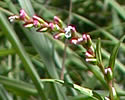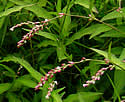Persicaria hydropiper (Marsh Waterpepper)
| Also known as: | |
|---|---|
| Genus: | Persicaria |
| Family: | Polygonaceae (Buckwheat) |
| Life cycle: | annual |
| Origin: | Europe |
| Status: |
|
| Habitat: | part shade, sun; moist to wet; shorelines, fens, forested wetlands, wet fields |
| Bloom season: | July - September |
| Plant height: | 8 to 30 inches |
| Wetland Indicator Status: | GP: OBL MW: OBL NCNE: OBL |
| MN county distribution (click map to enlarge): |  |
| National distribution (click map to enlarge): |  |
Pick an image for a larger view. See the glossary for icon descriptions.
Detailed Information
Flower: 

![[photo of flowers]](/udata/r9ndp23q/pd/persicaria-hydropiper-849238-5-t.jpg) Loose, erect to arching racemes, 2 to 7 inches long at the tips of upper branches and smaller clusters of a few flowers each arising from leaf axils. Flowers are white to pink, 1/8 inch long with 5 tepals (petals and similar sepals) that barely open and are nearly stalkless. The outer surface of the tepals are typically green with pink or white tips and dotted with tiny pits (magnification may be required to see clearly).
Loose, erect to arching racemes, 2 to 7 inches long at the tips of upper branches and smaller clusters of a few flowers each arising from leaf axils. Flowers are white to pink, 1/8 inch long with 5 tepals (petals and similar sepals) that barely open and are nearly stalkless. The outer surface of the tepals are typically green with pink or white tips and dotted with tiny pits (magnification may be required to see clearly).
Leaves and stems: 

![[photo of leaves]](/udata/r9ndp23q/pd/persicaria-hydropiper-849238-2-t.jpg) Leaves are alternate, mostly lance-shaped, pointed at the tip, tapered or wedge-shaped at the base, 1 to 4 inches long and to 1 inch wide, short stalked to stalkless. Leaf edges are toothless but with fine cilia-like hairs and are often wavy. At the base of the leaf stalk is a membranous sheath (ocrea) that extends up around the branch stem, with pale ribbing and short bristly hairs on its upper edge. Sometimes flower clusters are completely enclosed within the ocrea, causing it to noticeably bulge. Stems are erect to spreading, simple or branching, smooth throughout. When sprawling, it may root at the nodes in the lower plant.
Leaves are alternate, mostly lance-shaped, pointed at the tip, tapered or wedge-shaped at the base, 1 to 4 inches long and to 1 inch wide, short stalked to stalkless. Leaf edges are toothless but with fine cilia-like hairs and are often wavy. At the base of the leaf stalk is a membranous sheath (ocrea) that extends up around the branch stem, with pale ribbing and short bristly hairs on its upper edge. Sometimes flower clusters are completely enclosed within the ocrea, causing it to noticeably bulge. Stems are erect to spreading, simple or branching, smooth throughout. When sprawling, it may root at the nodes in the lower plant.
Fruit: 
Fruit is a dry seed, dull brownish black with a slightly rough texture.
Notes:
Marsh Waterpepper, formerly known as Polygonum hydropiper, is a fairly common weed. The wavy leaves resemble those of the native Swamp Smartweed (Persicaria amphibia), which is more easily distinguished by its thicker, bright pink flower spike at the tip of the stem. The dotted tepals resemble those of the native Dotted Smartweed (Persicaria punctata), which always has white to greenish flowers and only at stem tips, not in the axils.
Native Plant Nurseries, Restoration and Landscaping Services ↓
More photos
Photos courtesy Peter M. Dziuk.
Comments
Have you seen this plant in Minnesota, or have any other comments about it?
on: 2022-01-31 18:39:53
Shows up in disturbed wetlands where the soil has been exposed. Abundant for the first few years but soon overtaken by native perennials. If you are daring the leaves are extremely peppery like horseradish.







 Marsh Waterpepper plant
Marsh Waterpepper plant flower clusters arising from leaf axils
flower clusters arising from leaf axils a dense patch of Marsh Waterpepper
a dense patch of Marsh Waterpepper